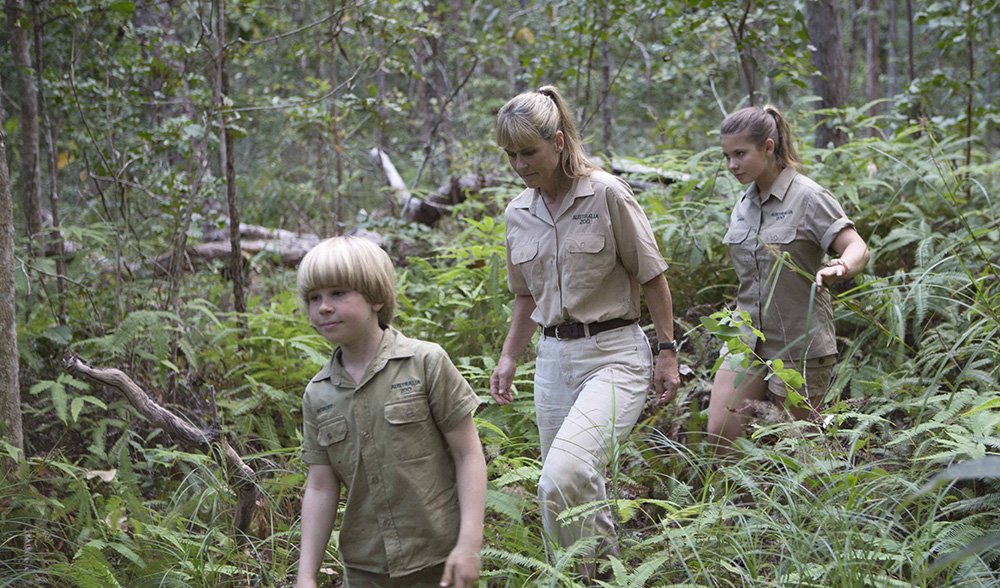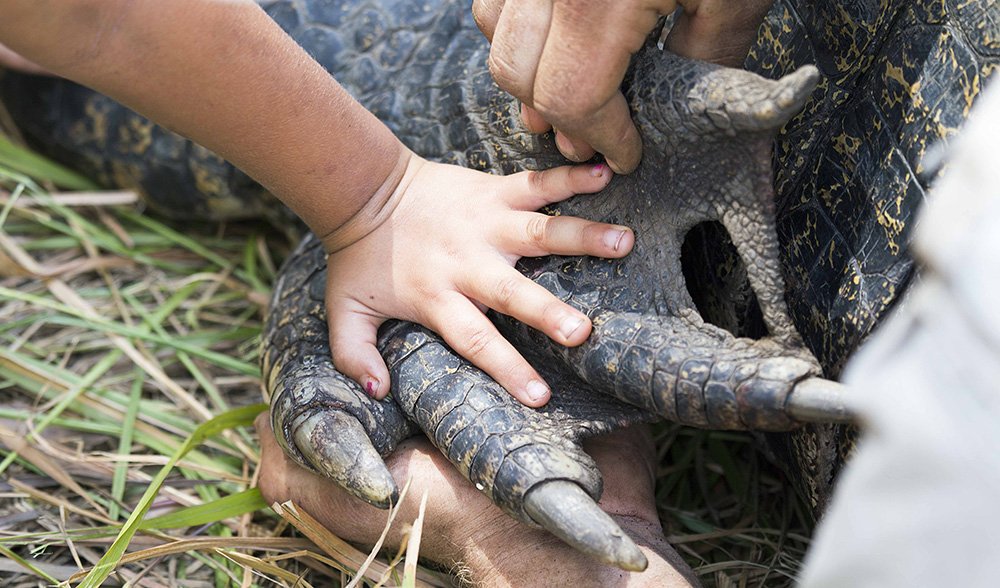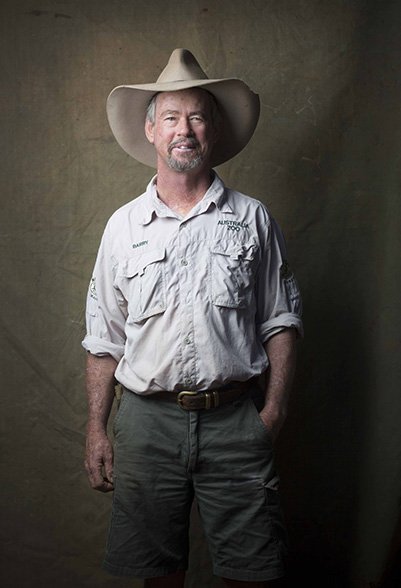Steve Irwin’s legacy lives on in Cape York

Many hands make light work of hauling the heavy steel trap out of the Wenlock River and up a sandy bank. The cage clears the brackish water and scrubby shoreline vegetation, and, along the pull ropes, necks are craning to catch a first glimpse of its contents. But this is no time for gawking; the clock’s ticking, the sun’s warming fast and hearts are racing as a crack squad of khaki-clad wildlife workers launches into a well-practised routine.
Inside the trap, a huge estuarine crocodile appears docile, momentarily mesmerised by the unfamiliar sights and sounds. Ropes are threaded through either side of the trap and looped around the creature’s top jaw. Once the chief wrangler is satisfied the ropes are correctly positioned, she crouches in front of the trap and issues the instruction to raise the gate.
A collective intake of breath hushes the small crowd of onlookers as we nervously watch Terri Irwin coax the creature out into the open. The lull is brief, for suddenly the crocodile springs from his metal prison and unleashes his fury, trying desperately to extricate himself from the ropes.

The ground beneath my feet vibrates with every roll as the hapless creature thrashes and writhes, binding the ropes ever more tightly around his snout. He expends all available energy in the effort and eventually gives up and quietens. It’s the moment the jump crew has been waiting for. Once more, Terri issues the instruction, and they leap forward as one, landing on the crocodile’s back, swiftly taping his jaws shut and fitting a blindfold over his eyes. It’s time for the drama to cease and the science to begin.
The ecologically significant Wenlock River flows through the Steve Irwin Wildlife Reserve (SIWR) in Cape York, one of four conservation properties in Australia Zoo’s portfolio, all of which are in Queensland. It’s here, since 2007, that the world’s most comprehensive crocodile study has been taking place.
I’m spending a few days with the team led by Professor Craig Franklin, director of research for the SIWR. The group, which includes Terri Irwin and her children, Bindi and Robert, spends a month here in the middle of the dry season each year to monitor the river’s crocodile population.
The reserve was acquired in July 2007 after the federal government signalled its wish to honour recently deceased Steve Irwin by renaming a national park in his honour. Terri requested a more hands-on memorial to her husband.

“I said that, with all due respect, we would like to proactively manage a property so that instead of just setting it aside in Steve’s name, we could do some positive things with it,” she says. That property turned out to be Bertiehaugh station, a 1350sq.km pastoral lease in remote Cape York, 55km north-east of the bauxite mining hub of Weipa.
Barry Lyon, a seasoned Cape York park ranger, had tracked crocodiles in the Wenlock River previously, so when it came to deciding upon a property, Terri and Craig sought his advice. “It was very near and dear to Steve’s heart because of the crocs, and Barry was the one who said it should be this place,” explains Terri.
Once they had purchased the property, Barry came on board to help run it and to develop a management plan. This is a requirement under the National Reserve System program (see AG 94), which stipulates that conserved areas must meet certain scientific criteria and strategically enhance the national network of protected areas.
“Through Barry’s hard work with a number of scientists, we’ve learnt that this place is so much more valuable than we ever anticipated,” Terri says. It was the Wenlock’s rich aquatic biodiversity, not least its high density of crocodiles, that originally drew Australia Zoo here.
Ultimately, though, it was a series of permanent freshwater springs associated with a bauxite (aluminium ore) plateau that will secure its status as a ‘strategic environmental area’ under the Queensland government’s new Cape York Regional Plan.

The plan seeks to balance environmental protection with sustainable economic development on the peninsula, and the new designation effectively ends a pre-existing bauxite mining option spreading over approximately 15 per cent of the reserve, including the plateau.
Not a great deal is known about the hydrology of the vast bauxite deposits that typify much of this remote area of Cape York. However, initial observations of the lush oases sustained by those perennial springs indicated that they might be a previously undocumented ecosystem type, found possibly nowhere else.
These cool, verdant havens among an otherwise dry eucalypt woodland landscape were the bitter battleground on which Australia Zoo fought for six years to halt a major project that would have seen a strip mine established across the plateau.
The eight springs, known locally as the Coolibah Springs complex, are inextricably linked to the geology of the plateau. It’s here that the porous bauxite acts like a giant sponge, filtering rainwater down to a deep sandy aquifer during the wet season and transmitting it progressively throughout the dry season to the springheads, where it eventually flows down to the Wenlock River.

According to Dr Marc Leblanc, a French-Australian hydrologist who specialises in semi-arid regions: “It’s pretty rare to find a large, permanent spring system in this climate, and very rare to have a spring that sustains such incredible ecosystems…all of them a little bit different, which makes it a very significant place in terms of what we call its eco-hydrology.” The plant communities associated with each of the springs vary, but each hosts rare or threatened species.
David Fell, a visiting botanist who undertook floristic assessments here, described an entirely new rainforest type at one spring, which is dominated by the striking and rare tiger stripe tree. Crucially, the oases provide habitat, refuges and corridors for a wide range of mammals, birds, amphibians, reptiles, fish and invertebrates and are culturally significant to the Teppathiggi and Attambaya people of the lower Wenlock basin. Certain springs served as women’s birth places, and many plants here were important for food and medicine.
The ongoing process of discovering and recording the area’s special natural values brings a range of scientists from many disciplines here each year. During my visit, alongside hydrologist Marc, there’s also a biologist studying a resident population of Australia’s largest crested parrot, the beautiful palm cockatoo.
But at this time of year, it’s typically croc researchers who are most conspicuous around Coolibah Camp. The airy tin shed serves as general HQ, makeshift lab, film-editing suite, amenities block and mess hall for a lively gaggle of scientists, rangers, volunteers, journalists, photographers and cooks.
Joining Craig Franklin in the field each year are brothers Dr Ross Dwyer – a colleague from the University of Queensland – and Dr Hamish Campbell from the University of New England. I sit with them around the refectory table the night before I’m scheduled to head out along the Wenlock to check crocodile traps with the rangers.

I’m excited by the prospect, but keen to understand the method and purpose of the research first. “It’s the largest and longest telemetry study on crocodiles ever to be conducted,” Craig says. “And, using acoustic telemetry, we’ll be tracking more than 100 crocodiles here for the next 7-10 years.”
The work is significant for the management of crocodiles that live close to human populations and therefore pose major safety risks. “In Queensland, problem crocodiles were translocated up until about 2008. Our research demonstrated that crocodiles will home and return to the same area once removed. Now translocation is no longer employed as a management strategy and crocodiles are removed permanently to farms,” Hamish says.
How crocs navigate, how far they travel, whether they maintain permanent territories, and how social hierarchies operate are among the questions the researchers seek to answer. The team has mapped a detailed picture of the Wenlock River group.
“Correlating acoustic and satellite tracking results with environmental variables such as currents and tidal systems, we’ve shown that…not only do they home, but they’ve got quite a detailed understanding of how currents work and will only travel when they are favourable,” says Ross. “They’ll climb up on a riverbank and wait till the current turns in the direction they want to go and then they just swim out and hitch a ride.”
The researchers have also observed that in pristine rivers such as the Wenlock, populations remain stable and balanced. Large, dominant males (longer than 4m) control movements in the river, and smaller males are forced to migrate, which accounts for some of the epic oceanic journeys recorded. This has important implications for the practice of removing the biggest crocs from waters close to human populations.
“We don’t know the effect that removing these large males might have on the dynamics of a river,” Hamish says. “If, from an area near people, you remove a large male that was controlling the movement of smaller 2-3m males, it could cause more of these smaller animals to move into that area.” Larger numbers of highly mobile young males pose a greater risk to humans, and so it’s vital to solve these puzzles quickly.
It’s why, the next morning, our big, beautiful saltie has been dragged from the river and is now lying under the weight of eight of us: Terri at the head and seven of us along the body. Craig works fast, assisted by Bindi, clearly relishing her role as technical assistant. First he scans for a tag. It’s a recapture. Juergen has been trapped twice before. This is great news, because it helps to build a detailed picture year on year. He’s measured, has blood taken and the acoustic tag that’s been surgically implanted is checked and replaced under a local anaesthetic.
Meanwhile, I’m awestruck to be touching a wild crocodile. I’d imagined the scaly skin to be hard like armour so I’m surprised by the soft texture of the scutes on his back. Juergen doesn’t move at all during the encounter, and, all along his massive 4.7m body, the jump team remains silent and respectful, trying hard not to disturb the creature more than necessary. Soon it’s time to release him; it’s by far the riskiest part of the process and those not directly involved, including me, are moved to a safe distance.
The blindfold and jaw tape are removed and the jump team gets ready to flee. Juergen, once free, will be at his most dangerous and could move like lightning in any direction. Hearts are once again pumping as everyone prepares for the call to release.
The order comes and the team scatters, the jaw ropes come away, and, after a brief hesitation, Juergen heads down the bank, disappearing with barely a splash beneath the coffee-coloured water. It’s a textbook operation. Steve Irwin taught his people well. They have perfected a capture and release method that eliminates the need to tranquillise the animals, and it’s a technique that has been adopted by other crocodile researchers around the world.
This article was originally published in the Sep-Oct 2014 issue of Australian Geographic (AG#122).




